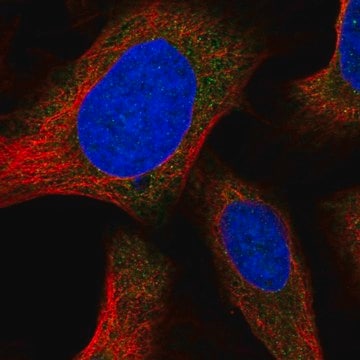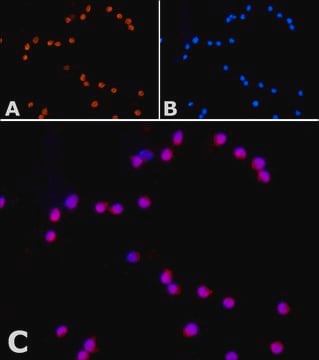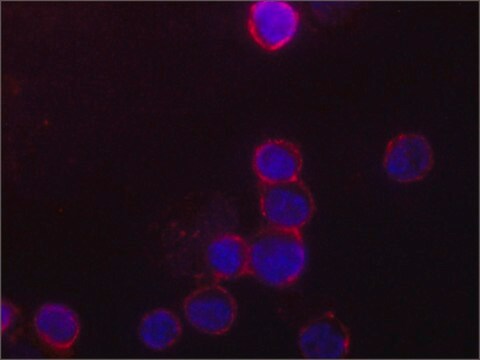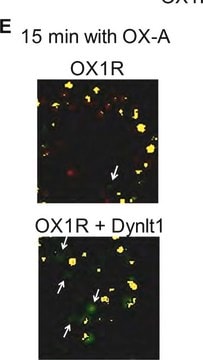AB9868
Anti-Orai1 Antibody, Intracellular
Chemicon®, from rabbit
Sign Into View Organizational & Contract Pricing
All Photos(1)
About This Item
UNSPSC Code:
12352203
eCl@ss:
32160702
NACRES:
NA.41
Recommended Products
biological source
rabbit
Quality Level
antibody form
affinity purified immunoglobulin
antibody product type
primary antibodies
clone
polyclonal
species reactivity
human
manufacturer/tradename
Chemicon®
technique(s)
western blot: suitable
UniProt accession no.
shipped in
wet ice
target post-translational modification
unmodified
Gene Information
human ... ORAI1(84876)
General description
TRP (transient receptor potential)-related ion channels (TRPCs) have been postulated as candidates for forming both receptor-operated (ROCE) and capacitative Ca2+ entry channels across the plasma membrane. ER transmembrane protein STIM1 senses the depletion of Ca2+ from ER stores. Orai, a regulatory β-subunit of the TRPC ion channel α-subunit, transduces the STIM1 signal into activation of the TRPC. Thus, Orai proteins by interacting with TRPCs act as regulatory subunits that confer STIM1-mediated store depletion sensitivity to these channels and regulate Ca2+ influx through the plasma membrane.
Specificity
ORai1, intracellular. Detects both the glycosylated and unglycosylated forms of ORai1. By Western blot the antibody reacts with the ~ 50 kDa ORai1 protein. Additional bands between 35 and 50 kDa may be seen if analyzing overexpressed ORai1. These additional bands most likely represent different degrees of glycosylation of ORai1
Immunogen
Synthetic Peptide from the Intracellular domain of Orai1
Application
Immunoblotting: 1:1,000-1:5,000
Immunofluorescence: 1:1,000-1:2,500
Immunoprecipitation: 1 µg
Optimal working dilutions must be determined by the end user.
Immunofluorescence: 1:1,000-1:2,500
Immunoprecipitation: 1 µg
Optimal working dilutions must be determined by the end user.
Research Category
Neuroscience
Neuroscience
Research Sub Category
Growth Cones & Axon Guidance
Growth Cones & Axon Guidance
This Anti-Orai1 Antibody, Intracellular is validated for use in WB for the detection of Orai1.
Target description
50 Kda
Physical form
Affinity purified immunoglobulin in PBS with 0.1% NaN3
Format: Purified
Storage and Stability
Maintain at 2-8°C in undiluted aliquots for up to 6 months after date of receipt.
Other Notes
Concentration: Please refer to the Certificate of Analysis for the lot-specific concentration.
Legal Information
CHEMICON is a registered trademark of Merck KGaA, Darmstadt, Germany
Disclaimer
Unless otherwise stated in our catalog or other company documentation accompanying the product(s), our products are intended for research use only and are not to be used for any other purpose, which includes but is not limited to, unauthorized commercial uses, in vitro diagnostic uses, ex vivo or in vivo therapeutic uses or any type of consumption or application to humans or animals.
Not finding the right product?
Try our Product Selector Tool.
Storage Class Code
10 - Combustible liquids
WGK
WGK 2
Flash Point(F)
Not applicable
Flash Point(C)
Not applicable
Certificates of Analysis (COA)
Search for Certificates of Analysis (COA) by entering the products Lot/Batch Number. Lot and Batch Numbers can be found on a product’s label following the words ‘Lot’ or ‘Batch’.
Already Own This Product?
Find documentation for the products that you have recently purchased in the Document Library.
Sung Hee Lee et al.
Oncotarget, 7(28), 43239-43255 (2016-06-04)
Emerging evidence indicates that Orai1, a key calcium channel for store-operated Ca2+ entry, is associated with human cancer. However, the underlying mechanism by which Orai1 regulates cancer progression remains unknown. Here we report that intracellular level of Orai1 is increased
Jimena Laporta et al.
PloS one, 9(10), e110190-e110190 (2014-10-10)
Lactation is characterized by massive transcellular flux of calcium, from the basolateral side of the mammary alveolar epithelium (blood) into the ductal lumen (milk). Regulation of calcium transport during lactation is critical for maternal and neonatal health. The monoamine serotonin
Beibei Wu et al.
eLife, 10 (2021-12-16)
CRAC channel regulator 2 A (CRACR2A) is a large Rab GTPase that is expressed abundantly in T cells and acts as a signal transmitter between T cell receptor stimulation and activation of the Ca2+-NFAT and JNK-AP1 pathways. CRACR2A has been
Beibei Wu et al.
Cell reports, 36(8), 109603-109603 (2021-08-26)
Sustained activation of the Ca2+-release-activated Ca2+ (CRAC) channel is pivotal for effector T cell responses. The mechanisms underlying this sustainability remain poorly understood. We find that plasma membrane localization of ORAI1, the pore subunit of CRAC channels, is limited in effector
Stefanie L Makowski et al.
Molecular and cellular biology, 35(2), 451-467 (2014-11-12)
The signal peptide peptidase (SPP)-related intramembrane aspartyl proteases are a homologous group of polytopic membrane proteins, some of which function in innate or adaptive immunity by cleaving proteins involved in antigen presentation or intracellular signaling. Signal peptide peptidase-like 3 (SPPL3)
Our team of scientists has experience in all areas of research including Life Science, Material Science, Chemical Synthesis, Chromatography, Analytical and many others.
Contact Technical Service








